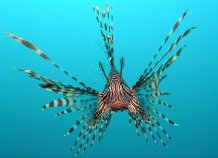
Lion fish are thought to have reached new oceans after being released from aquariums.
From pet to ‘perfect invader’ - the spread of lionfish
A predatory fish species thought to have reached new oceans after being released from aquariums is the “perfect invader”, an expert has said.
Lionfish first appeared off the coast of Florida in the 1980s and – after a slow start – they are now found over a vast area, said Dr Isabelle Côté, of Simon Fraser University in Canada.
Speaking at the University of Exeter, Dr Côté said lionfish – native to the Indo-Pacific – “made the jump” from the US east coast to coral reefs in Bahamas in 2004 and spread quickly through the Caribbean and the Gulf of Mexico, and are now found as far south as Brazil.
The origins of the invasion are not know for certain, but the US National Ocean Service says: “Experts speculate that people have been dumping unwanted lionfish from home aquariums into the Atlantic Ocean for up to 25 years.”
Dr Côté said lionfish – now found in “every habitat”, from coral reefs and mangroves to sea grass and shipwrecks – have various traits which have allowed them to spread so quickly.
“If you were to design the perfect invader you’d probably design something pretty similar to lionfish,” she said.“They eat things that are up to half their size – and they’re pretty big fish.”
She said lionfish were “really fat” in the Bahamas – growing much larger than in their native habitats – and have been seen eating dozens of other fish species.
They are patient predators, stalking their prey for up to five or six minutes before striking.
“Three times out of four they catch the thing that they’re stalking,” Dr Côté added.
She said lionfish have poisonous spines which make them unappealing to predators – but they are known to attack and eat each other like cannibals. Remains of other lion fish have been found in their stomachs.
Dr Côté was speaking at the 50th Anniversary Symposium of the Fisheries Society of the British Isles, hosted by the University of Exeter.
Date: 6 July 2017
